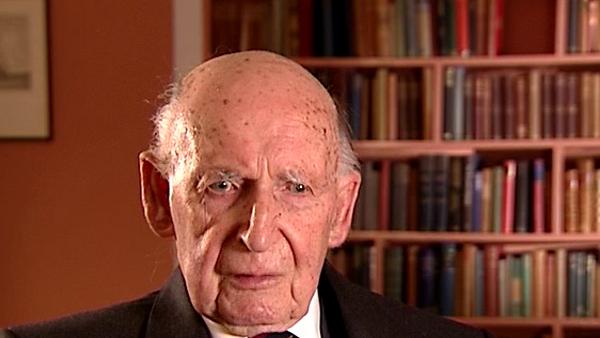NEXT STORY

A visit to Fylingdales and my retirement
RELATED STORIES

NEXT STORY

A visit to Fylingdales and my retirement
RELATED STORIES


|
Views | Duration | |
|---|---|---|---|
| 101. The first picture of the surface of the Moon | 153 | 03:13 | |
| 102. Working between the Soviets and Americans | 125 | 05:51 | |
| 103. America successfully lands on the Moon | 130 | 04:57 | |
| 104. A visit to the Telecommunications Research Establishment in... | 114 | 02:03 | |
| 105. Work for the Air Ministry | 77 | 03:28 | |
| 106. Jodrell Bank's involvement in the Cuban missile crisis | 145 | 07:41 | |
| 107. Important work enabled by use of the steerable telescope | 88 | 02:51 | |
| 108. A visit to Fylingdales and my retirement | 163 | 03:47 |

I'm often asked what I think was the most important work, research work, done with the 250ft steerable telescope, and I... it's very difficult for me to answer that because I... so much work has been done I don't like to offend all the people who've done their own splendid work with the telescope. Of course, it's easy to say, well, of course the recording of Sputnik, which is true because that saved us. I mean, I doubt if that hadn't happened, that Jodrell would exist.
I... I still believe that the use of the telescope for the first few years after 1957 by Henry Palmer and his group on the measurement of the angular diameters of the radio sources turned out to be most important. The position was this. I think by that time Ryle had carried out many of his intergalactic measurements in Cambridge and it was perfectly clear that after this tremendous argument that went on between the people who believed that all the apparently point sources, or sources of small diameter, which were being rapidly discovered and revealed by the interferometers, they... they were... the great argument emerged as to whether they were all confined to the local galaxy or were... or were extra-galactic. And... and there was a most violent argument in a meeting of the Royal Astronomical Society some time in the 1950s between Gold, Tommy Gold, and Hoyle on the one hand, and... and Ryle and his people on the other, who argued. Gold particularly was a vehement that these point sources, we often call them, or localised sources were mainly from an extra galactic nebulae. But incidentally, both worked independently, and... and Ryle had published other papers attempting to prove that they were unknown star like objects with... in the local galaxy. Well, we did not get directly involved in that argument because it... by the time the... Henry Palmer started his work on... on the measurement of angular diameters, it was being fairly well established that most of these localised or point sources were indeed extra galactic.
Bernard Lovell (1913-2012), British radio astronomer and founder of the Jodrell Bank Observatory, received an OBE in 1946 for his work on radar, and was knighted in 1961 for his contribution to the development of radio astronomy. He obtained a PhD in 1936 at the University of Bristol. His steerable radio telescope, which tracked Sputnik across the sky, is now named the Lovell telescope.
Title: Important work enabled by use of the steerable telescope
Listeners: Megan Argo Alastair Gunn
Megan Argo is an astronomer at the University of Manchester's Jodrell Bank Observatory researching supernovae and star formation in nearby starburst galaxies. As well as research, she is involved with events in the Observatory's Visitor Centre explaining both astronomy and the history of the Observatory to the public.
Alastair Gunn is an astrophysicist at Jodrell Bank Observatory, University of Manchester. He is responsible for the coordination and execution of international radio astronomical observations at the institute and his professional research concerns the extended atmospheres of highly active binary stars. Alastair has a deep interest and knowledge of the history of radio astronomy in general and of Jodrell Bank in particular. He has written extensively about Jodrell Bank's history.
Tags: Sputnik 1, Jodrell Bank, Cambridge, Royal Astronomical Society, H P Palmer
Duration: 2 minutes, 51 seconds
Date story recorded: January 2007
Date story went live: 05 September 2008